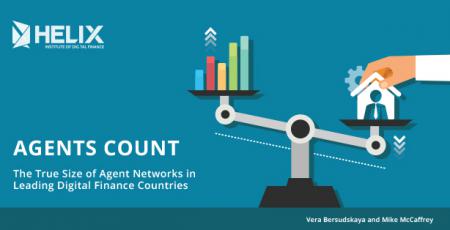Defining terms and options for measuring access to digital finance
by Vera Bersudskaya and Mike McCaffrey
Mar 3, 2017
5 min
This article summarizes recommendations from a newly released paper titled “Agents Count”, containing some initial suggestions for addressing the reasons why providers have not been able to accurately measure the number of active agent outlets in their territories.
The first blog in this series explained that currently, countries do not have systems for counting the number of active agent outlets on their territories. This must be remedied as this statistic is fundamental for measuring access to finance, with leading financial inclusion efforts around the world planning to use it as an indicator of progress.
The reasons why we have not been able to accurately measure this in the past are two-fold. First, as an industry, we have not taken the time to define key terms like “agents” or “activity”. This has led to confusion over what is being measured, and how the resulting metrics can be used. The second is that we have not been collecting the data necessary to accurately and consistently measure key indicators. This article summarizes recommendations from a newly released paper titled “Agents Count”, containing some initial suggestions for addressing these issues.
Key Definitions for Agent Networks
To measure access to finance, we need to first count (and geo-locate) all active agent outlets. This would allow us to understand the number of physical locations offer financial services in a geographical area or in relation to a population. This indicator can then be used to track progress across time periods or places.
To date, the industry has been using two different methods to count agents. The first is to add up the number of agent tills, which are special SIM cards or POS machines agents use to perform transactions. The other is to count the number of physical locations in which these tills are used. Unfortunately, much of the literature uses a generic term “agent”, leaving the reader unsure of what is being discussed.
Further, the counting of tills is much more common: it is what regulators, GSMA, the IMF and the World Bank do. The reality in most countries, however, is agent locations often carry multiple tills. Consequently, the total till count is much higher than the total number of agent outlets. Presenting agent tills rather than outlets leads to overestimates of financial access. Hence, when discussing access to finance provided via agents, we need to draw the distinction between “agent tills” or “agent outlets” and be clear which figures we use.
Beyond this, from access to finance perspective, we should only care about tills or outlets that are actually operational and offering services. Alas, here again, we lack a consensus on what defines an agent (till or outlet) as active. Some organisations use a 30-day rate, while others use a 90-day rate. We recommend that the industry uses 30-day rates at a bare minimum since even one transaction per month is unlikely to earn the agent enough commission to motivate her to continue investing in float. In the paper, we also suggest that providers maintain an even more stringent definition, which we discuss.
Methods for Collecting Data on Agent Outlets
Hopefully, the industry will move to standardise the two key definitions above, but even once there is clarity on definitions, we need data to measure corresponding indicators. There are three main options for collecting this data, all with their own pros and cons.
- Agent censuses can be collected regularly to count the number of agent outlets in a country. The obvious benefit of this method is that it is easy to understand, our calculations in the paper validate the accuracy of existing censuses. The downside is, given how costly and time-consuming they are, we doubt that most countries would conduct them regularly.
- Compliance data cum agent surveys is a somewhat cumbersome but cheaper alternative. Regulators could insist on collecting 30-day active till statistics from providers. These figures could be adjusted down using the information on the number of tills agent outlets carry obtained through nationally representative agent surveys, using formulas outlined in “Agents Count”. The Helix Institute has conducted such surveys in eight countries, demonstrating that while this option also involves fieldwork, it is much more economical in terms of time and money compared to a census. The benefit of this methodology is it builds on compliance data already being collected by regulators and requires limited additional fieldwork. Further, our paper shows that the calculations are just as accurate as completing a full census. The con is the need for regular data collection as levels of multiple tills outlets host keeps evolving.
- Geo-located agent registries could be a sustainable long-term solution, which builds on a census and is regularly updated. Regulators could develop specialised data collection apps, which would enable automated updates to the registry. Such apps could pull in data from providers’ internal systems, including 30-day activity rates and any other compliance data required. While this option is promising, the major con is it has not been implemented. The Bank of Tanzania is currently working on a similar application but is yet to launch. The major advantage is that much more could be done with this data in terms of geo-spatial analysis of access to finance.
Recommendations for Measuring Access to Digital Finance
- The industry needs to adopt standardised definitions for both agent outlet and agent till to eliminate any confusion. Vetted through discussions with key international organisations, the following definitions can form the basis for industry consensus on agent terminology:
- Agent till: a provider-issued registered “line”, either a special SIM card or a POS machine, used to perform enrollment, cash-in and cash-out transactions for clients.
- Agent outlet: a physical location that carries one or more agent tills, enabling it to perform enrollment, cash-in and cash-out transactions for clients on behalf of one or more providers. Agent outlets may also have other businesses and support functions.
- Registered agent is a term used in the industry to refer to agent tills. This term should be avoided as it has been confusing in the past.
Moreover, the industry should agree on a standard definition of “active”, which we recommend being “at least one transaction in past 30-days”.
- Regulators should go farther in collecting and disseminating financial inclusion data. At the minimum, they should insist that providers also report agent till 30-day activity rates. While many already do, all regulators should share agent data on their websites, as well as with the IMF and the World Bank for their respective FAS and GPSS reports.
- Public sector organisations should ensure progress against financial inclusion targets is measured accurately. Organisations working to promote financial inclusion should coordinate to determine the best methods for collecting data on key progress indicators. Then, they should provide the technical and financial support needed to ensure the appropriate data are collected widely, accurately, and frequently.
Please find a link to the full text of the new report: “Agents Count: The True Size of Agent Networks in Leading Digital Finance Countries”.
Written by

 by
by  Mar 3, 2017
Mar 3, 2017 5 min
5 min

Leave comments